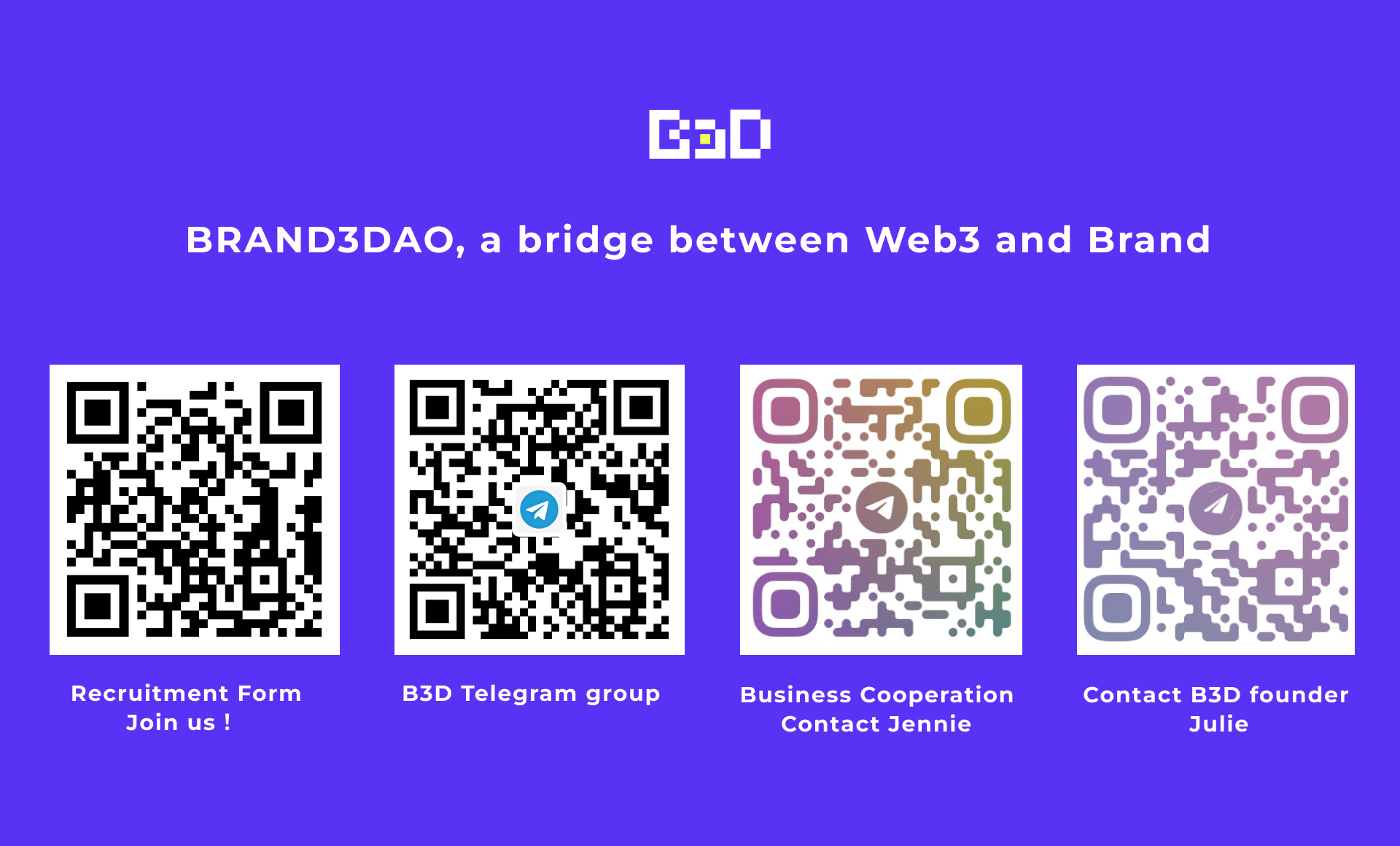Originality: @Brand3DAO
Editors: Payne, Julie, Jennie
Translated by: Suki, Yuki
The intense decline in 2022 once again plunged the cryptocurrency market into another winter, and the slight recovery in the first month of 2023 has generated expectations of a new bull market and has prompted individuals to seek answers on: What is the key to unlocking the next bull market?
The origin and catalyst of the 2020 bull market cycle were DeFi and NFT, which created new wealth and markets. The majority of individuals who are proficient in utilizing wallets and various blockchain products are seasoned blockchain users and their sustained endogenous driving force is a crucial source of overall market growth. However, the conclusion as to whether they are the key movers behind new funds and markets remains subject to debate.
Regardless, one thing is certain: the reason why the blockchain industry has reached a scale of $2 trillion is because of the influx of new funds, new users, new technology, and the critical channels that connect these increments. Whether it's Robinhood's ability to trade digital assets, Gray Scale's launch of futures ETFs, or even the further expansion of CEXs — they have all lowered the threshold for the general public to access and trade digital assets, gradually bringing non-mainstream assets into mainstream view. Lowering the threshold and making it easier for more users to participate in Web3 is a prerequisite for expanding the market. CZ's latest AMA speech also confirms the optimistic outlook and attention in this direction: Binance will continue to invest and make Defi more accessible and usable. The product team will also continue to simplify the KYC process.
“The early bird gets the worm.” Funds, users, and developers are rushing into the world of Web3 like a tidal wave. However, within the rich but fragmented ecosystem of Web3, new funds face an explosion of information on various value narratives, new users struggle to adapt to complex and chaotic operating logic, and new developers enter a cycle of repeating wheel-reinventing and wasting resources.
Facing such a situation, we can't help but think: if we could develop a unified operating system for Web3, similar to the development of the Android system that changed the landscape of the mobile internet, it would lower the barriers of entry to Web3 and break down the walls between different ecosystems, creating the necessary conditions for a large-scale explosion of DApps within Web3.
Through this article, we will review the revolutionary impact of the Android system on the development of mobile internet, compare it with the current situation faced by Web3, and explore: How can a unified Web3 operating system trigger the next bull market?"
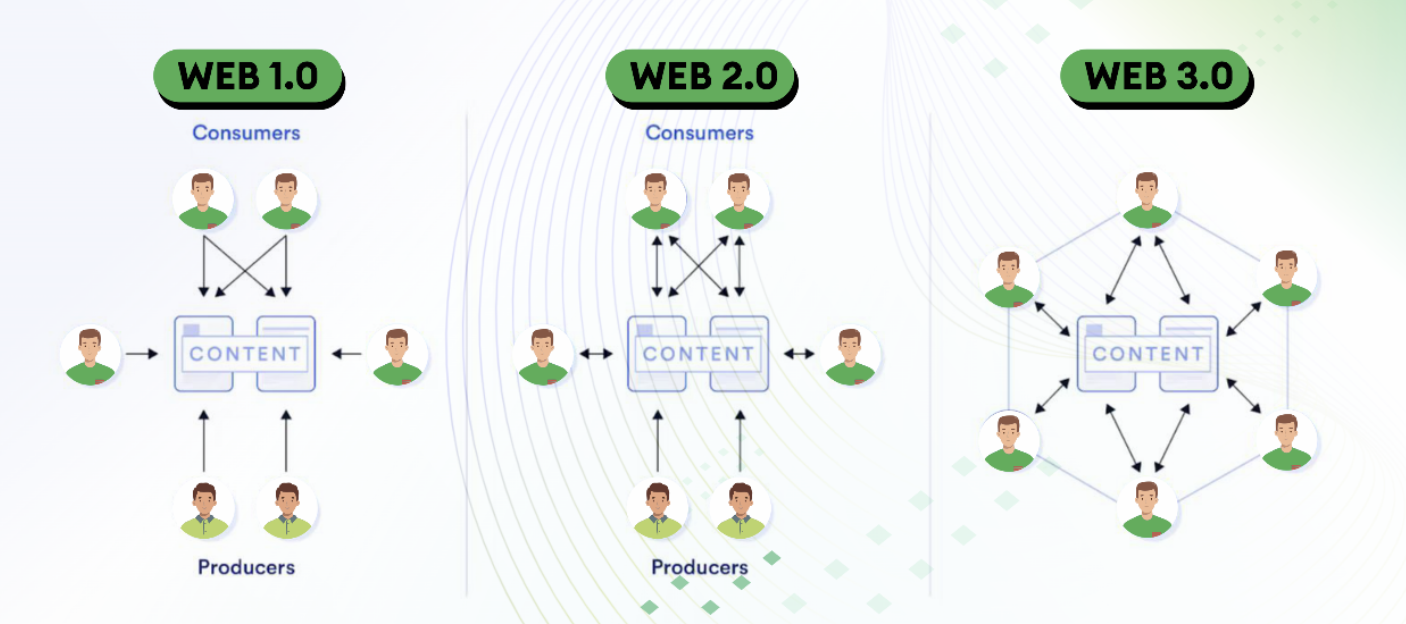
The current state of Web3 applications: a connected consensus, a disconnected ecology
Disagreement and consensus are alive together, and closure coexists with connectivity.
In the Web3 ecosystem, Layer 1 public chains each carve out their own territories based on differences in TPS (speed), application diversity, security, cost of use, and other factors, and build upper layer structures (DApps) that meet different user needs on top of these territories. The explosive growth of public chains has brought about a seemingly prosperous but actually chaotic scene - after experiencing the "steam era" in the DApps of one public chain, users need to re-enter the "stone age" in another chain. The fragmented public chain ecology brings great inconvenience to both users and developers. For example, users need to perform cumbersome operations to switch between ecosystems, and developers need to repeat the process of project deployment and later operation on different public chains. In short, in the blue ocean where prosperity and fragmentation coexist, pain points surge, and opportunities are hidden.
The term "pay to play" in the context of Web3 has a different interpretation compared to its conventional usage. Newcomers to on-chain services must secure initial gas through centralized exchanges or friends to pay for transaction fees. Without this fuel, they are restricted to simply observing, unable to execute any actions. Participating in liquidity mining or NFT transactions requires transferring assets from the initial chain such as ETH to the necessary chain on the platform. For instance, to provide liquidity to SpookySwap through Fantom, several steps are required: download the wallet plugin, recall the mnemonic phrase, obtain FTM as gas, acquire USDC on ETH, authorize cross-chain usage of USDC, transfer USDC from ETH to Fantom, authorize SpookySwap to use USDC on Fantom, trade, and authorize SpookySwap to use LP. This convoluted process makes it challenging to attract the average internet user, who may find it too complicated. Even experienced users may miss out on trading opportunities or face difficulties due to the complexity of the process or a misstep in choosing the incorrect chain. Despite the existence of numerous innovative DApps, the absence of a unified operating system makes it hard to bring in more users to Web3.
The problem with the early mobile Internet
Board the time-machine, let's take a trip down memory lane to the infancy of mobile internet. Back then, transferring photos between phones from different brands required downloading software, uploading photos to a computer, and downloading another software to transfer photos to another phone. To play the same game on different platforms, users had to log in to different servers, but their in-game progress and purchases could not be transferred. Making transfers or transactions involved waiting in line at a bank counter or logging in through an online banking interface with a U-disk verification. Despite the robust irreplaceability of mobile internet technology at the time, its various problems only attracted a small number of tech-savvy users and leaders.
For developers, platform fragmentation and device differences pose a nightmare. In the early days of Web2 development, these issues primarily arose from the adaptation problems of different language codes and device screen sizes. Many times, the development team would choose to abandon software adaptation for certain devices in order to avoid the inefficient work that comes with repetitive development, or they would simply use software for other screen sizes and resolutions to make up numbers, completely disregarding the user experience.
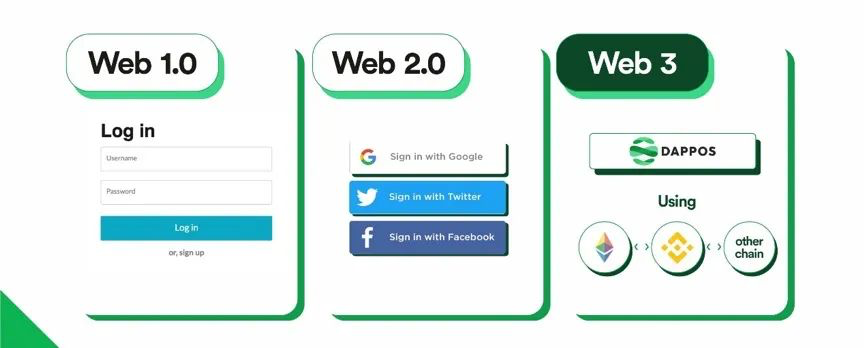
Comparison between the current status of Web3 and the early mobile Internet
In the early days of the mobile internet era before the advent of the Android system, phone manufacturers experienced similar difficulties to those faced by today's major public chains in many ways. A comparison of the details is presented in the following table:
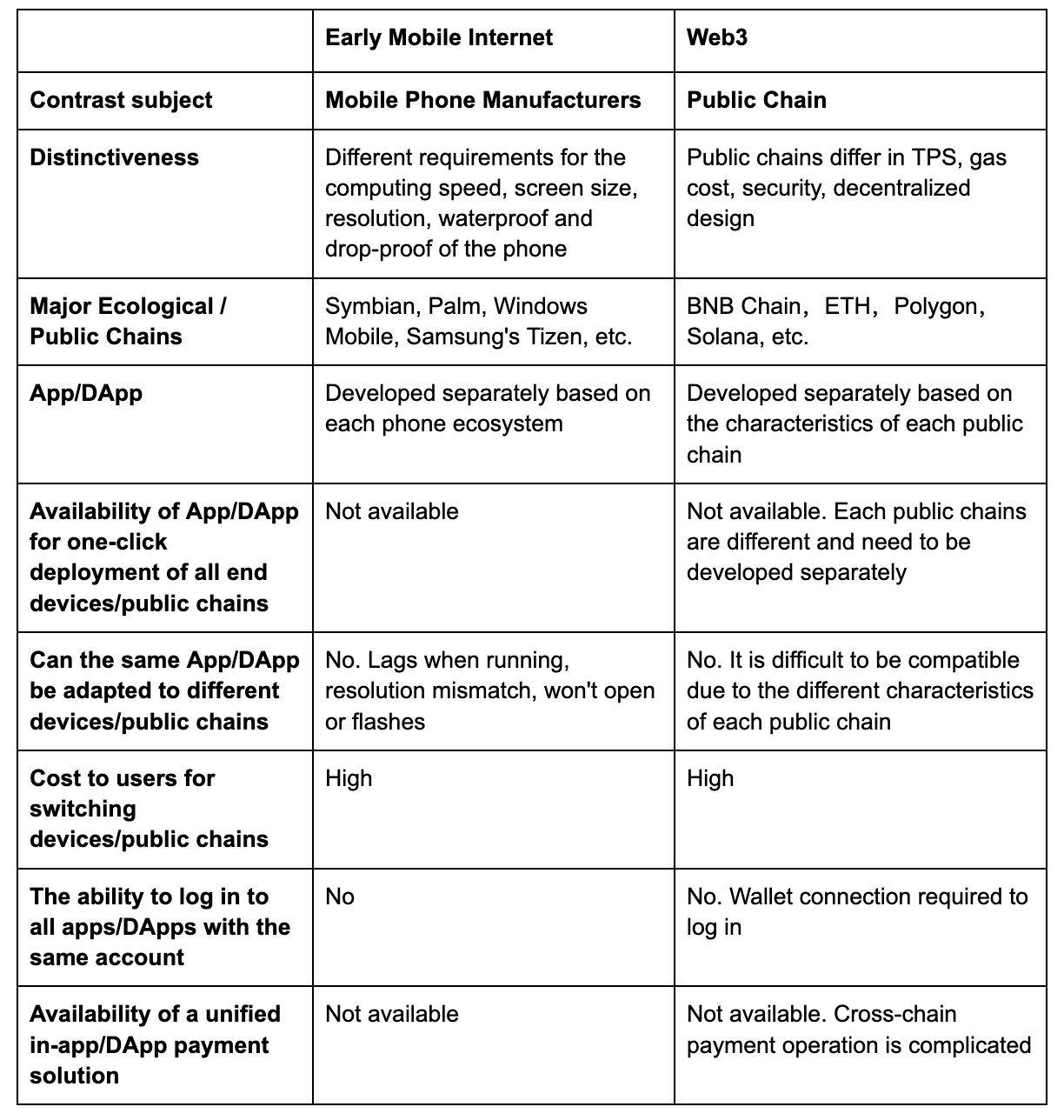
The issues faced by early phone manufacturers became even more serious in Web3. Not only is efficient DApps multi-chain development and deployment difficult on a technical level, the flow of funds between chains is also greatly impacted. "To be wealthy, build roads first." Due to the lack of liquidity on different chains, deploying a project (DApp) to a new chain means having to start from scratch in building liquidity. The project party must incur high costs in operating the new chain to increase liquidity.
The best user experience is characterized by minimal actions and interactions. However, when interacting with DApps in the Web3 ecosystem, users are required to engage with their wallets, and manual actions are necessary to switch between different ecosystems when experiencing different DApps. This greatly increases the difficulty of interaction and goes against the principles of good user experience, which has already been validated and eliminated in the Web2 market. Without a smooth and easy-to-use experience, it is difficult to attract and retain users and to encourage them to explore more content within the DApps.
The current issues in Web3 not only significantly affect user engagement, discourage user's on-chain interactions and consumption behaviors, but also increase the resistance for developers to expand their business, indirectly limit the quality of DApp projects and restrict the adequate development of the industry due to limitations in capital flow. Solving this issue in the current bear market would break through the past technological barriers and system ecological barriers just as the birth of the Android system did, initiating a new revolution in the development of mobile internet, and the next bull market will surely prosper on a completely new, broader basis.
Seeking for the commonality of views and perspectives
The future of Web3 and crypto is being evaluated by users, developers, and VCs in terms of user experience, development difficulty, and market potential. Among them, Joey Krug, CIO of Pantera Capital, provides an objective summary of the issues in the market and the general direction of solutions.
-
First and foremost, there are issues surrounding the user experience (UX) of wallets. Although MetaMask has done a lot for the market, it is a simple browser extension and not a robust application with carefully designed user experience. Its layout is confusing, it might leave new users bewildered, and the UI is too complex. It reminds me of the old-fashioned Palm or Windows handheld devices that existed before the iPhone. Perhaps a long-term solution is a retail wallet based on MPC.
-
The second issue is that transaction fees must be paid in ETH. This requires ETH in addition to any asset being sent/traded/transacted. The idea of economic abstractions solves this problem by locally upgrading the Ethereum protocol to allow for the payment of transaction fees with tokens other than ETH.
-
The third issue is about integrating better legal portals into decentralized applications (DApps). Currently, there is a lack of a locally integrated solution for decentralized applications similar to popular market integrations like Stripe. This would allow dApps to add fiat portals and allow users to purchase cryptocurrencies through simple clicks with low fees. However, this solution does not yet exist and requires embedding as a widget in the UI, with no one controlling the UI (i.e. the DApp). Currently, Stripe's new crypto portal product does not solve this problem.
Based on the current pain points, this article summarizes the four characteristics that a solution should have:
-
Provide developers with a standard development and deployment environment, and a unified and prosperous user software ecology.
In the software field, there is a saying: "The beauty of simplicity" (worse is better). No one would reject such a beautiful ecosystem: different types of merchants can operate normally within it and provide services to all users; users can enjoy the content and services they need without spending too much time and learning costs; users can freely use and trade their assets. In the fierce competition of the mobile Internet market, there is already an ecosystem dominated by the Android system to serve Web2 users. Therefore, for Web3, if it can provide standardized and unified SDK, allowing developers to efficiently develop and easily deploy development environments, while users can maintain the same usage habits on any device and platform and experience various content and services, such an ecosystem will undoubtedly become the playground for users, gathering place for developers and funds in the Web3 world.
-
Provide users with a unified account login experience, UI design, and a senseless cross-chain experience with Dapps
The best design is intuitive and self-explanatory. Streamlining the login process and steps of an application can lower the user's difficulty in using the product, reflecting the high quality of the product. A Google account can be used to log into Android apps with just one click, providing access to the services offered by the app. The user's software preferences and usage history can be saved in the Google account, and even if the password is forgotten, it can be reset through authentication methods. This kind of user experience is one of the reasons why users continue to use Google services.
In the Web3 ecosystem, users are required to use mnemonics to verify and log into their wallets, which serve as passwords to access the encrypted wallet. As users' data and assets are distributed across different chains, the process of forgetting passwords or conducting cross-chain data and asset operations can become complex and have a significant impact on user retention. Therefore, ensuring a seamless UI experience for users during cross-chain and DApp switching, as well as implementing a unified login system using Google accounts and an account recovery feature, are crucial for the desired user experience in Web3.
-
Automate multi-chain and multi-task operations for users with a single interaction
In Web3, completing a task on a single chain or multiple chains requires multiple steps, resulting in complex operations and poor user experience. Taking liquidity mining as an example, a user needs to go through five contract interactions (approve tokens A/B, add liquidity, approve LP tokens, deposit) to achieve the goal of pooling. This calls for a payment technology that can help simplify the process, a user-friendly UI with the capability to handle multiple tasks and multiple operation bundling. With just one click, the DApp should be able to assist the user in completing all interactions, including Gas payment, cross-chain transactions, and repetitive contract interactions such as approve, thereby enhancing the user experience and reducing the likelihood of users abandoning Web3 due to complex operations.
-
Uniform and convenient payment technology can be built-in by DApp
People have grown accustomed to the convenient payment functions within apps, whether in shopping or transaction scenarios, making it difficult to revert to the era of bank queue transfers or using U-key to log into online banking. With Google Pay, all one needs to do is confirm transaction information, enter the amount (sometimes it's automatically displayed), choose the account where the funds are located, and confirm the transaction to complete the payment process. However, in Web3, users must adapt to the limited payment capabilities provided by DApps, as different DApps support different tokens, making it difficult for users to use existing tokens for payment or transactions, and sometimes requiring transfer through centralized exchanges to obtain tokens that meet the requirements of the DApp. Therefore, Web3 requires a payment method similar to Google Pay that can provide users with complete, convenient, and token-supported payment functions within DApps, making the user experience as convenient as traditional payment methods.
Feasible Solutions
In the ecology of the Web3 unified operating system, various projects are competing for the lead. The richness, user experience, and interconnectivity of the DApps within the ecology are largely determined by different ecological designs. The unified ecology has a fundamental and critical role in Web3, many large funds and top centralized exchanges are starting to pay attention and provide support. It can be predicted that the competition for a unified ecology will become more intense in the future.
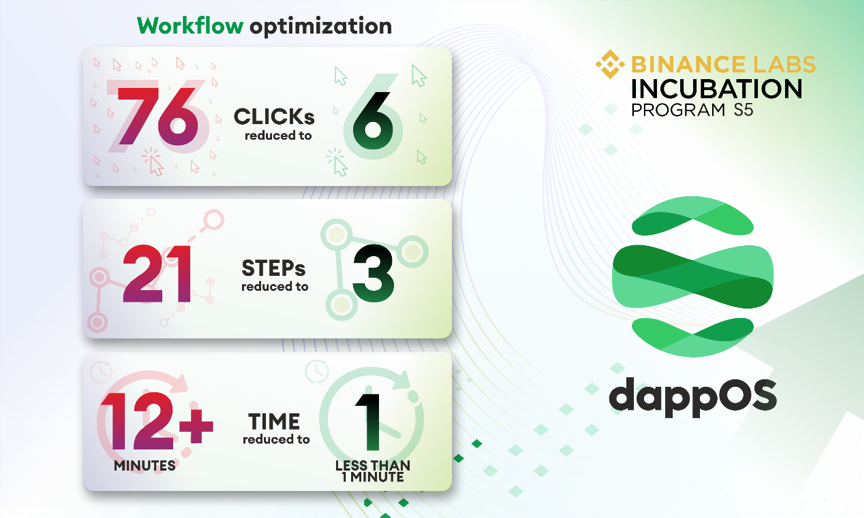
As a leading centralized exchange, Binance has also placed its focus on the ecological construction area. Among numerous ecological projects, Binance's Binance Lab recognizes dappOS as one of its acknowledged potential projects and includes it in its fifth incubation plan. This means market opportunities, community support, and institutional guidance will be provided to the project. dappOS provides a comprehensive SDK in terms of functionality, operation, speed, fees, and security, indicating its unique characteristics and advantages. Additionally, dappOS also provides a Mini Program Platform, offering a unified and convenient payment function for DApps within the ecosystem and users who use DApps. For example, features such as recovery of virtual wallets, automatic handling of complex settlements by the system, and multi-asset serving as Gas fees demonstrate its greater potential in comparison to competitor projects.
Solutions to achieve the technological revolution of Web3
1. dappOS Account
In dappOS, users use contract-based accounts, known as virtual wallets, instead of traditional externally owned accounts (EOAs). Typically, if a user forgets the mnemonic phrase to log in to their wallet, the assets in the wallet will be permanently unrecoverable. However, dappOS Accounts can be reset in these cases through various means. As a result, users can use and reset virtual wallets in dappOS without the need for mnemonic phrases. With dappOS Accounts, users can easily log into dappOS with a single click, eliminating the hassle of mnemonic phrases, and conforming to the usual app usage habits as if logging into Web2 apps.
The virtual wallet has scalability and can address the issue of needing to have gas in order to use the wallet. The virtual wallet not only allows third parties to pay for gas, but also supports other assets (such as tokens, assets in centralized exchanges, and even fiat currency) to pay for gas fees. Additionally, when the user's balance is insufficient, the system can automatically retrieve equivalent assets from the user's other chain for combined payment after the user confirms, similar to how Alipay supports paying with both balance and bank card. dappOS, for the user's first interaction with each new chain, will automatically create a virtual wallet with unique attributes based on the different new chains, making it easier for the user to find the correct wallet when executing cross-chain operations, and also paving the way for one-click automated execution of multiple tasks.
2. dappOS Network
The dappOS Network provides automated execution services for users. This means that with just a signature confirmation from the user, the dappOS Network will perform interaction operations on multiple chains using virtual wallets, including cross-chain payments, exchanges, and multiple chain and task operations. Tasks that may have previously required over 10 minutes of manual operation can now be completed in less than a minute with the help of dappOS Network's "one-click confirmation.
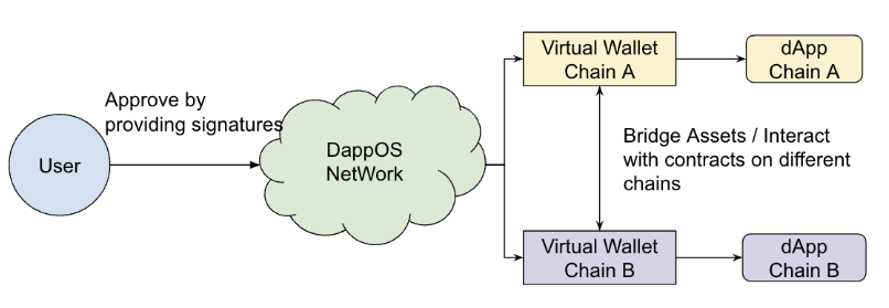
The consensus mechanism of dappOS is implemented through nodes, and there are two types of nodes.
-
The Supernode: Accepts the user's delegated orders and assigns them to server nodes, supervises completion, and provides rewards and punishments.
-
The Service Node: Responsible for assigned orders from the supernode and executing them, and upon completion, receiving a certain amount of token reward.
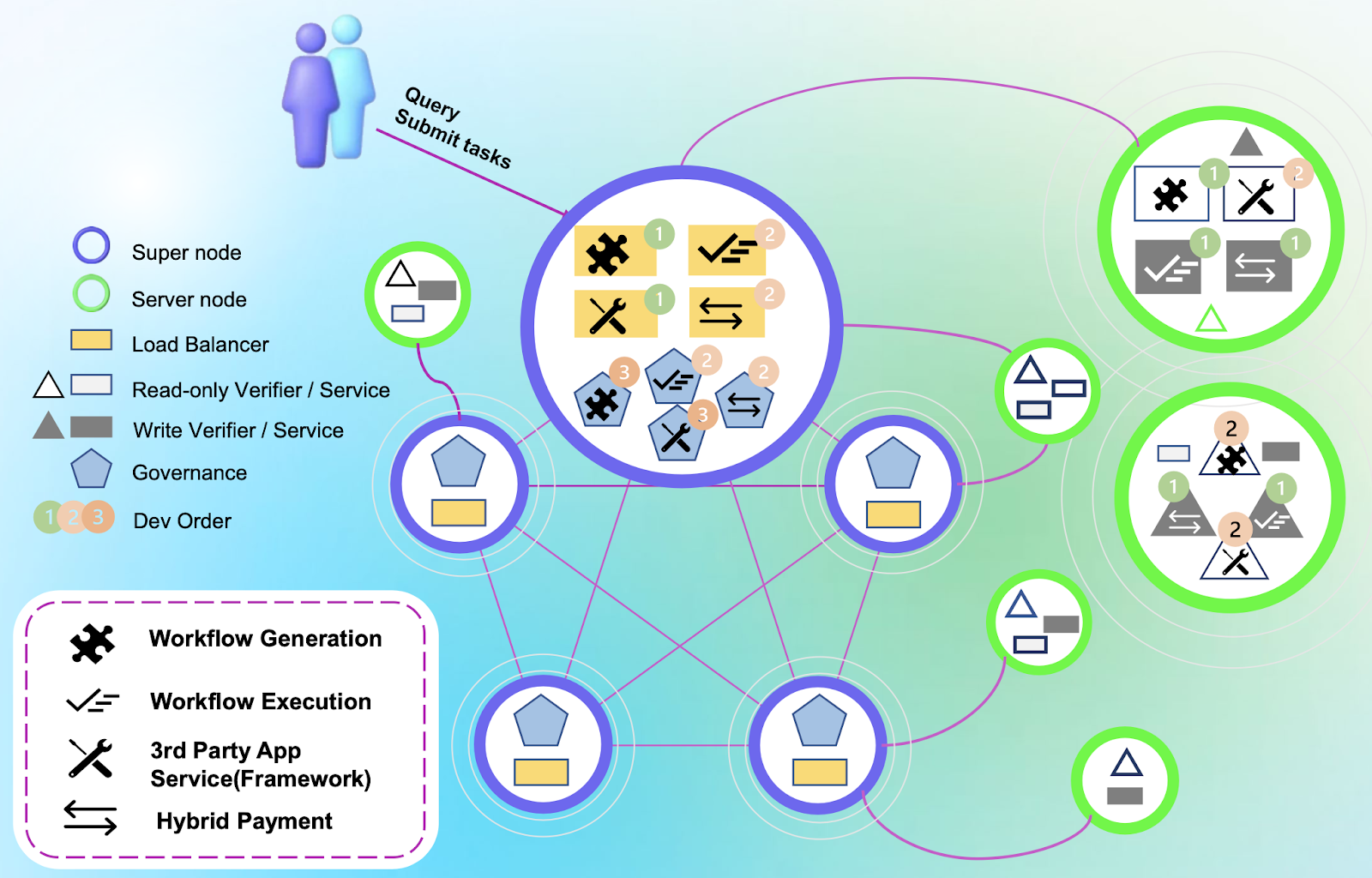
Through this consensus mechanism, the service nodes and super nodes cooperate to ensure the smooth completion of cross-chain requests or multi-step operations submitted by users. To become a super node, one needs to first pledge platform coins, but can earn platform coin-formatted commission income by executing delegated orders; service nodes can obtain corresponding income from the commission fees of executing delegated orders.
3. dappOS SDK
When developers deploy a DApp on multiple chains, the DApp SDK provides a simplified solution to help A-chain users experience B-chain DApps without having to redeploy contracts to attract mobility. For example, a DApp deployed on the BNB Chain can easily attract users from the ETH Chain without having to guide them across chains, purchase gas, or set up a wallet. Deploying a DApp on multiple chains allows developers to effectively connect users between chains, replicate their advantages on the A-chain to the B-chain, and save time and effort in operating a new chain. For developers, dappOS makes it possible to deploy on multiple chains with one-click through SDK integration. Meanwhile, the Mini Program Platform will soon be launched, allowing users to experience a Web2-like user experience on DApps and continue their familiar usage habits and experiences.
4. dappOS provides one-click, automated payments for DApps
Users who are used to paying for orders and bills through apps should be very familiar with the built-in payment system in apps. DappOS also aims to provide a similar experience for DApp users. From supporting gas payments, cross-chain interactions, to contract approvals, users just need to confirm the payment information (mainly the amount) and click once to confirm. DappOS will automatically complete all operations. Besides the public chain transactions that need to wait for a while to confirm, other aspects are basically the same as the payment experience in Web2 applications.
DeFi as the foundation of the next cryptocurrency cycle, and also due to its naturally complex operations, has become a leading adopter of dappOS. DeFi platforms such as Perpetual, Benqi, and QuickSwap have all integrated dappOS as a tool for users to exchange tokens, enhancing the user experience. In the past, users had to spend 30 minutes exchanging tokens before they could enter the platform to trade or participate in liquidity mining, but based on dappOS's automation advantages, it only takes a single click and a few minutes of confirmation time to achieve the result that could only be accomplished manually in 30 minutes before.
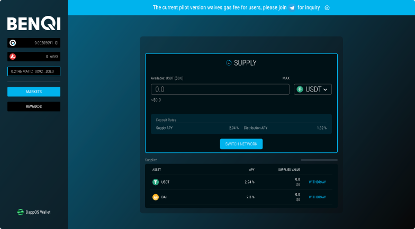
Recently, the Farming Activity between dappOS and QuickSwap has sparked discussions among users on Twitter regarding their participation in this "new payment model".
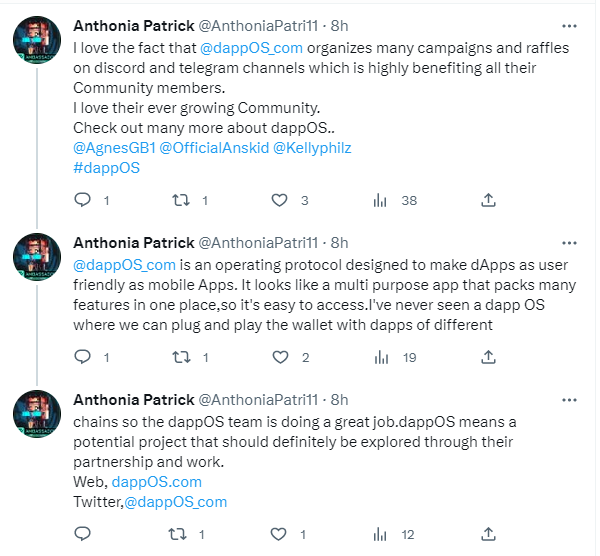
Leading DeFi protocol GMX has also reached a deep collaboration with dappOS, and the GMX platform integrated with the dappOS SDK preview product has officially launched, providing the seamless user experience empowered by the dappOS Web3 operating protocol. This collaboration will lower barriers to entry for users to access GMX DeFi functions on the Arbitrum and Avalanche blockchains, with smart recommendations based on fees and liquidity. Users can enjoy a consistent and smooth operation experience and interact with top DApp ecosystems.
In order to encourage users to experience multi-chain fusion technology, dappOS will join GMX to give interaction airdrops to the first batch of experienced users.
Product link: https://gmx.dappos.finance/trade
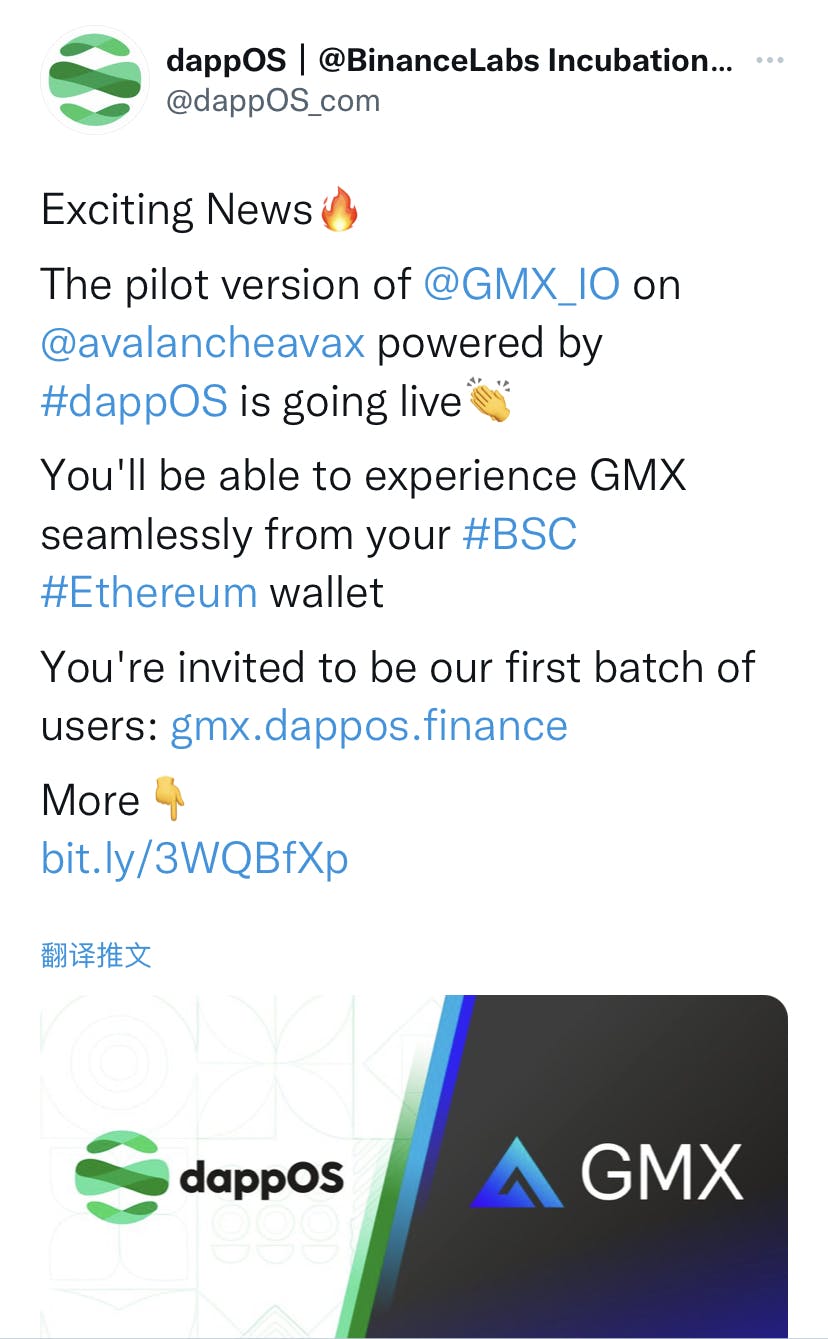
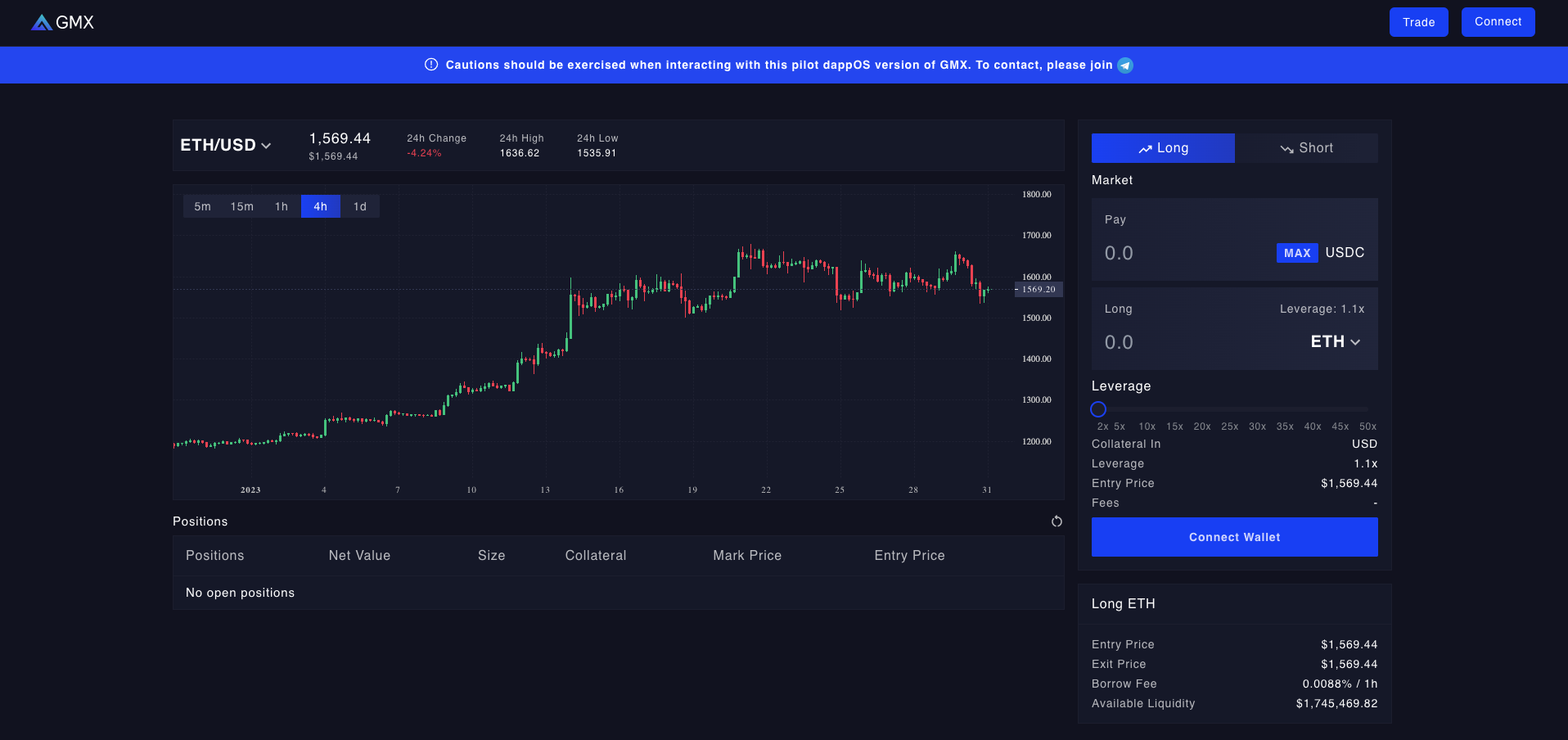
Can dappOS be the Android of Web3?
The Android system played a crucial role in the development of mobile internet. In Web3, Android system means DApps can run on Web3's unified operating system and infrastructure. By comparing the solution of Android system and dappOS to ecological issues, it can be seen that dappOS's technical approach to improving user experience, supporting developers, and building a unified payment system within DApps is very similar to the functions of Android system in Web2.

Thus, dappOS aims to offer more comprehensive and effective support to Web3 users and developers through a unified and standardized technology solution. From DApp development and deployment to user experience, from seamless integration to streamlined operations, from cross-chain payments to multitasking packaged processing, dappOS endeavors to create a novel environment for Web3 that appeals to users, developers, and potential investors alike.
Conclusion
In the early days of the mobile internet, phone manufacturers competed against each other without considering the impact of ecological issues on users and developers. The advent of the Android system provided a unified ecosystem for app developers, allowing users to enjoy a rich array of services and content. Later, a unified payment function was introduced, creating a positive feedback loop between users, developers, and Android, leading to the healthy development of the Android ecosystem.
dappOS is dedicated to becoming the first Android in Web3. It provides a unified ecosystem by offering SDKs and standardized protocols, allowing DApps' content and services to take root. It also provides a simple and user-friendly UI and a one-click execution of multi-task packaging operations based on single or multiple chains, ensuring users' operation security while improving user experience. By collaborating with various DApps, dappOS also provides payment functions, increasing the cross-chain payment needs within Web3, attracting more users and funds into Web3, bringing huge potential and motivation for the future development of the DApps ecosystem.
The positive feedback loop between users, developers, and dappOS creates the necessary conditions for creating an "Android system" in the Web3 world and will sound the horn for explosive growth of DApps in the next bull market.
